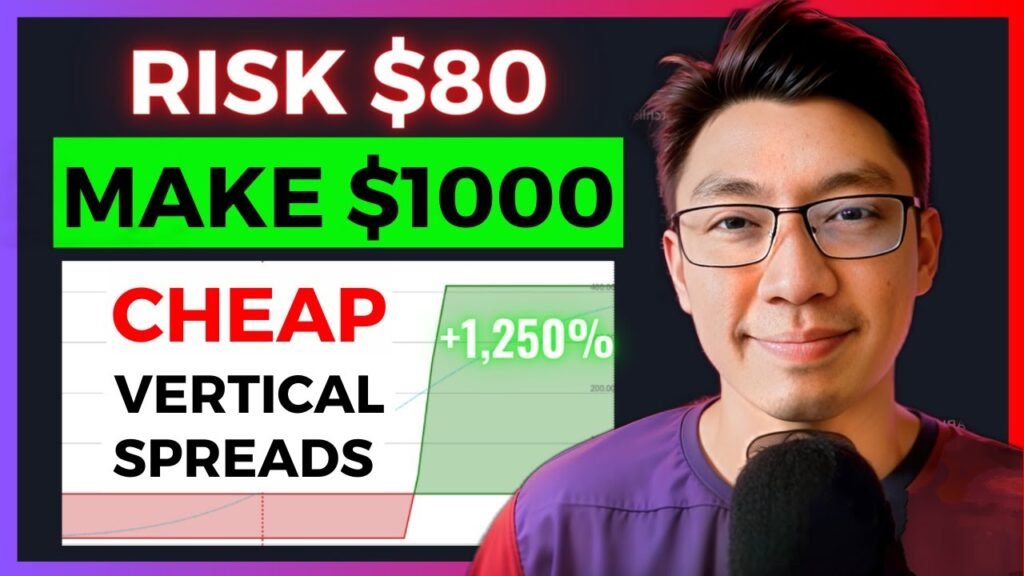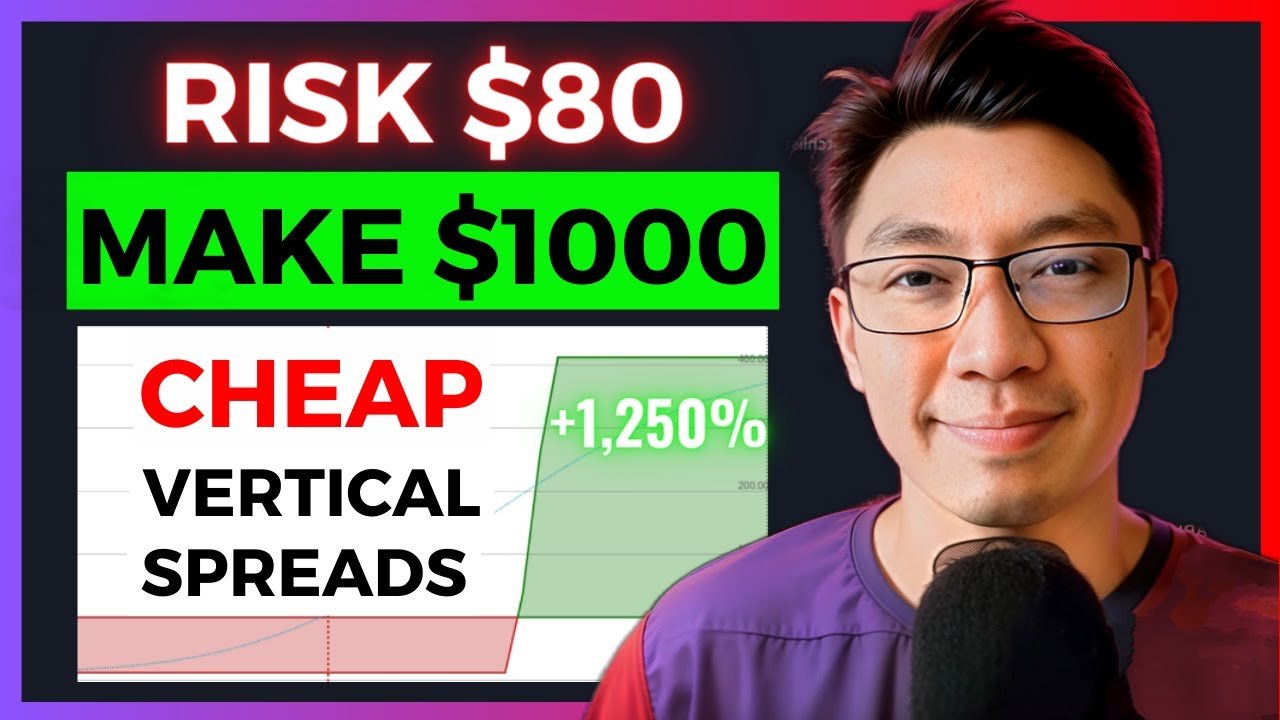You’ve stumbled upon a valuable resource discussing the art of trading cheap vertical spreads for a living, all while risking under $100. In this insightful video by Options with Davis, the concept of cheap vertical spreads is thoroughly explored, shedding light on both the debit and credit types. By explaining the risk-to-reward ratio, professionals in the field provide a clear understanding of how this strategy can lead to favorable outcomes with low capital risk. With detailed explanations of adjusting spread width and exploring further out-of-the-money spreads, this video equips you with the knowledge needed to potentially make profitable trades.
As you consider whether trading cheap vertical spreads is a viable option for you, it’s essential to grasp the pros and cons associated with this strategy. While the low capital risk and favorable risk-to-reward ratio stand out as advantages, there are potential downsides to be aware of. The strategy’s low probability of profit at expiration could lead to long losing streaks, impacting your psychology as a trader. However, with a deeper understanding of the risks involved, you can navigate the world of trading options skillfully and possibly capitalize on the benefits of cheap vertical spreads.

Types of Vertical Spreads
Vertical spreads are a popular options trading strategy that involves buying and selling options with the same expiration date but different strike prices. There are two main types of vertical spreads: debit spreads and credit spreads. Debit spreads involve paying money to enter the trade, while credit spreads involve receiving a premium upfront. Each type of vertical spread has its own unique characteristics and benefits.
Debit Spreads
Debit spreads are a type of vertical spread where you pay money to enter the trade. There are two main types of debit spreads: call debit spreads and put debit spreads. Call debit spreads involve buying an out-of-the-money call option and selling a further out-of-the-money call option. Put debit spreads involve buying an out-of-the-money put option and selling a further out-of-the-money put option. Debit spreads are considered “cheap” because they can be constructed for a relatively low cost, often as little as $50 or less.
Call Debit Spreads
Call debit spreads, also known as bull call spreads, involve buying an out-of-the-money long call option and selling a further out-of-the-money call option. This strategy allows traders to benefit from a bullish market outlook while limiting their risk to the premium paid for the spread. Call debit spreads are popular among new traders due to their low capital risk and potentially favorable risk-reward ratio.
Put Debit Spreads
Put debit spreads, also known as bear put spreads, involve buying an out-of-the-money long put option and selling a further out-of-the-money put option. This strategy allows traders to profit from a bearish market outlook while capping their potential losses. Put debit spreads offer a low-cost way to speculate on downward price movements in the underlying asset.
Risk to Reward Ratio for Call Debit Spreads
The risk to reward ratio for a call debit spread is an important consideration when evaluating the potential profitability of the strategy. For example, if you construct a call debit spread with a risk of $80 and a potential profit of $400, the risk to reward ratio would be 1:5. This means that for every $1 you risk, you could potentially make $5 in profit. A favorable risk to reward ratio can make call debit spreads an attractive trading strategy for those looking to maximize their profit potential while limiting their risk exposure.
Pros of Trading Cheap Vertical Spreads
Trading cheap vertical spreads offers several advantages for traders looking to minimize their risk while maximizing their profit potential. Some of the key pros of trading cheap vertical spreads include:
Low Capital Risk
One of the primary benefits of trading cheap vertical spreads is the low capital risk involved. By constructing spreads for as little as $50 or less, traders can enter positions with limited downside exposure. This allows traders to participate in the market with a small initial investment, making vertical spreads an accessible strategy for traders of all experience levels.
Favorable Risk Reward Ratio
Vertical spreads typically offer a favorable risk-reward ratio, allowing traders to potentially earn a significant profit relative to the amount of capital at risk. By structuring spreads with a risk-reward ratio of 1:5 or better, traders can increase their profit potential while limiting their losses. This can make vertical spreads an attractive trading strategy for those seeking high-profit opportunities with controlled risk.
Adjusting Spread Width to Reduce Risk and Cost
Traders can adjust the width of their vertical spreads to reduce risk and cost. By widening or narrowing the spread between the strike prices of the options, traders can tailor their positions to their risk tolerance and profit objectives. Widening the spread can increase the cost and risk of the trade, while narrowing the spread can decrease the cost and risk. This flexibility allows traders to customize their vertical spreads to suit their individual trading preferences.
Potential Profitability
Trading cheap vertical spreads offers the opportunity to make hundreds of dollars with a low-risk strategy. By entering positions for as little as $50 or less, traders can potentially earn significant profits if the market moves in their favor. Further out-of-the-money spreads can be even cheaper and more profitable, offering traders a cost-effective way to speculate on price movements in the underlying asset. With a careful risk management strategy and an understanding of options trading, traders can capitalize on the profit potential of vertical spreads while managing their risk exposure.
Understanding Options Trading
Options trading involves buying and selling options contracts based on the price movements of underlying assets. While options offer the potential for high returns, they also carry a high level of risk. It’s important for traders to understand the pros and cons of trading options before entering the market. Some key points to consider when trading options include:
Pros and Cons of Trading Options
Options trading offers a range of benefits, including leverage, diversification, and the ability to profit from both rising and falling markets. However, options trading also carries risks such as time decay, volatility, and the potential for unlimited losses. Traders should carefully weigh the pros and cons of options trading before entering the market to ensure they understand the risks involved.
Low Probability of Profit at Expiration with Long Options
Long options, such as buying call and put options, have a low probability of profit at expiration. In order for a long option position to be profitable, the underlying asset must be above the strike price for calls or below the strike price for puts at expiration. This low probability of profit means that traders may experience more losing trades than winning trades when trading long options, making risk management crucial to long-term success.
Impact of Underlying Asset’s Position on Strike Price and Profitability
The position of the underlying asset relative to the strike price of the options contract has a significant impact on the profitability of the trade. If the underlying asset is above the strike price for calls or below the strike price for puts, the options contract may be profitable at expiration. Traders must carefully monitor the movement of the underlying asset and adjust their options positions accordingly to maximize their profit potential.
Risk Management in Trading
Risk management is a critical aspect of trading cheap vertical spreads and options in general. Traders must consider the probability and win rate baked into options strategies, as well as the impact of a low win rate strategy on potential losing streaks and psychological well-being. Some key points to consider when managing risk in trading include:
Probability and Win Rate Baked-In Options
Options strategies have probability and win rate baked into their design, meaning that traders know the likelihood of the trade being profitable upfront. Understanding the probability of profit and win rate of an options strategy allows traders to assess the risks and rewards of the trade and make informed decisions about their trading strategy.
Impact of Low Win Rate Strategy on Potential Losing Streaks and Psychology
Trading strategies with a low win rate can lead to long losing streaks, which can have a significant impact on a trader’s psychology. It’s important for traders to manage their risk exposure and avoid emotional decision-making during periods of drawdown. By implementing a robust risk management strategy and maintaining a disciplined approach to trading, traders can mitigate the psychological impact of losing streaks and remain focused on their long-term trading goals.
In conclusion, trading cheap vertical spreads offers an accessible and potentially profitable strategy for traders looking to minimize risk while maximizing profit potential. By understanding the characteristics of vertical spreads, the risk to reward ratios, and the impact of options trading on profitability and risk management, traders can develop a well-rounded trading strategy that aligns with their goals and risk tolerance. With careful planning, risk management, and a disciplined approach to trading, traders can leverage the benefits of vertical spreads to achieve long-term success in the options market.
